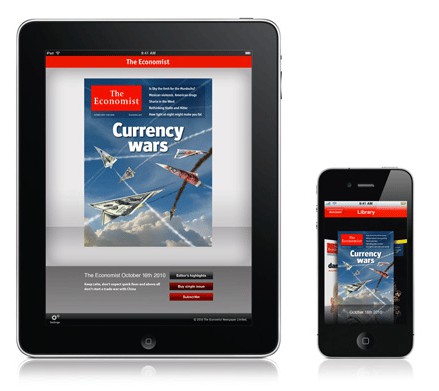
The Economist said more than three million of its iOS and Android apps have been downloaded, as it reported six percent higher half-year operating profit of £26.2 ($40.49) million.
“The demand for digital editions has exceeded our expectations. Readers have downloaded the Apple (NSDQ: AAPL) and Android versions to more than three million tablets and smartphones, and The Economist is read on more than one million of these devices every month.
“That figure includes those who read the editor’s weekly choice of six free articles, which allow potential subscribers to sample the newspaper. The Economist online is also growing strongly. The number of monthly visitors has risen by 45% since September 2010, to more than seven million.”
Extracts from Roy Greenslade’s interview with Economist Group CEO Andrew Rashbass, who says tablet publishing is more akin to print than web.
“‘When I was struggling to position the website, I made a mistake, which turned out to be a positive mistake. I thought we should do the same online as we did in print, simply transferring from one platform to the other. But we carried out research around the world among educated people who didn’t read the Economist and discovered, to our surprise, that it wasn’t what they wanted.’
“(Rashbass) says they came to realise that there was a distinction between what he calls the ‘lean-back, immersive, ritual pleasure’ of reading the Economist in print compared to the ‘lean-forward, interactive’ way people used the site.
“It was, says Rashbass, the difference between ‘snacking on the net as against the gourmet meal of reading in print‘. That convinced him and his team to offer an entirely different experience to website users. Rather than lecturing the audience, they set out to build a community of people eager to participate in discussions with the magazine’s journalists and with each other.
“Then along came the e-readers and tablets. ‘We suddenly realised that if we were making a distinction between lean-back and lean-forward, here was lean-back digital or lean-back 2.0. We made a conscious choice to avoid the web-style interactive approach. Instead, we saw the potential of delivering a better lean-back experience than we have ever achieved in print.’”
“He argues that the Guardian cannot hope to secure enough advertising revenue to create content through its traditional commissioning model, while the Times cannot attract subscribers who are one click away from free content elsewhere. Claiming that both loss-making papers survive by cross-subsidy, and therefore have the same business model, he argues, predictably, that he speaks from a unique position of business strength.”